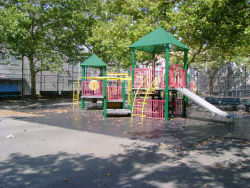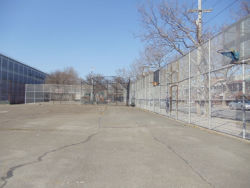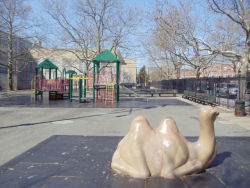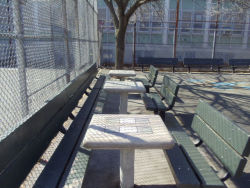Wilson Playground
Wilson Playground
\WILSON PLAYGROUND
What was here before?
In the 1800s, this part of Brooklyn, Canarsie was part of the Township of Flatlands. In 1896, Flatlands became part of Brooklyn, and Canarsie became an independent neighborhood. In 1898, Brooklyn merged with New York City, forming the Borough of Brooklyn. Canarsie saw the arrival of railroads from the Brooklyn Rapid Transit Company in the mid-1800s, and in 1906, the company opened a sandpit at Avenue J and East 99th Street. This sandpit was used as a "burial ground" for over 100 trolley cars until its closure in 1936. Today, two-family houses stand where the cars were buried.
How did this site become a park?
The City acquired the property in 1956, and it was transferred to NYC Parks in 1960. Originally known as J.H.S. 211 Playground, it became a Jointly Operated Playground (JOP), serving both the school and the local community. Starting in 1938, the Board of Education (now the Department of Education) agreed to provide land next to schools for NYC Parks to build and maintain playgrounds that could be used by the school during the day and by the public when school was not in session.
The playground features a camel play sculpture, game tables, and a yardarm flagpole. Red, yellow, and green play equipment with safety surfacing was installed during a rebuilding of the park in 1997. In addition to the handball courts, sporting areas include basketball courts and a baseball diamond play area.
The multipurpose play areas were reconstructed in 2023 upgrading the basketball and handball courts.
What is this park named for?
The playground was renamed in 1986 in honor of John Marshall Wilson (1847-1918), a Civil War Veteran and Justice of the Peace, who spent his entire working life in Canarsie.
At age 16, Wilson enlisted in the Civil War and fought in the Battle of Gettysburg with the New York Company E, 17th Regiment. After the war, he returned to his hometown of Canarsie, where he became a dedicated community leader. In 1886, he won a limited term as Justice of the Peace after the retirement of Voorhees Overbaugh (1817-1893). By 1887, he was elected for a full term and often mediated local disputes to foster harmony among residents. In 1888, he was promoted to Associate Justice.
That same year, Wilson provided protection for Kings County Prohibition Society officials enforcing drinking restrictions. After Democratic party boss Hugh McLaughlin (1827-1904) stepped down, Wilson took over as party boss. In 1891, he successfully blocked a proposed Flatbush sewer project that would have run through Canarsie and was honored with a diamond locket at a community ceremony.
During the 1894 coal strike, Wilson chartered a vessel to bring coal from New Jersey for Canarsie, Brownsville, and New Lots residents, an effort he repeated several times. In the 1890s, during a smallpox epidemic, he established strict quarantine measures to protect the community. Wilson retired from his judicial role in 1895.
Check out your park's Vital Signs
Clean & Safe
Green & Resilient
Empowered & Engaged Users
Share your feedback or learn more about how this park is part of a
Vital Park System




